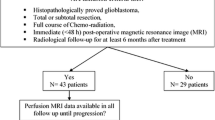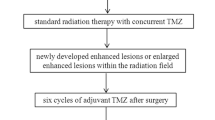Abstract
Purpose
Regorafenib is a multikinase inhibitor, approved as a preferred regimen for recurrent glioblastoma (rGB). Although its effects on prolonging survival could seem modest, it is still unclear whether a subset of patients, potentially identifiable by imaging biomarkers, might experience a more substantial positive effect. Our aim was to evaluate the potential value of magnetic resonance imaging-derived parameters as non-invasive biomarkers to predict response to regorafenib in patients with rGB.
Methods
20 patients with rGB underwent conventional and advanced MRI at diagnosis (before surgery), at recurrence and at first follow-up (3 months) during regorafenib. Maximum relative cerebral blood volume (rCBVmax) value, intra-tumoral susceptibility signals (ITSS), apparent diffusion coefficient (ADC) values, and contrast-enhancing tumor volumes were tested for correlation with response to treatment, progression-free survival (PFS), and overall survival (OS). Response at first follow-up was assessed according to Response Assessment in Neuro-Oncology (RANO) criteria.
Results
8/20 patients showed stable disease at first follow-up. rCBVmax values of the primary glioblastoma (before surgery) significantly correlated to treatment response; specifically, patients with stable disease displayed higher rCBVmax compared to progressive disease (p = 0.04, 2-group t test). Moreover, patients with stable disease showed longer PFS (p = 0.02, 2-group t test) and OS (p = 0.04, 2-group t test). ITSS, ADC values, and contrast-enhancing tumor volumes showed no correlation with treatment response, PFS nor OS.
Conclusion
Our results suggest that rCBVmax of the glioblastoma at diagnosis could serve as a non-invasive biomarker of treatment response to regorafenib in patients with rGB.



Similar content being viewed by others
Data availability
The data that support the findings of this study are available upon reasonable request.
References
Stupp R, Mason WP, van den Bent MJ et al (2005) Radiotherapy plus concomitant and adjuvant temozolomide for glioblastoma. N Engl J Med 352:987–996. https://doi.org/10.1056/NEJMoa043330
Birzu C, French P, Caccese M et al (2020) Recurrent glioblastoma: from molecular landscape to new treatment perspectives. Cancers (Basel) 13:47. https://doi.org/10.3390/cancers13010047
Calabrese C, Poppleton H, Kocak M et al (2007) A perivascular niche for brain tumor stem cells. Cancer Cell 11:69–82. https://doi.org/10.1016/j.ccr.2006.11.020
Chen J, Li Y, Yu TS et al (2012) A restricted cell population propagates glioblastoma growth after chemotherapy. Nature 488:522–526. https://doi.org/10.1038/nature11287
Bao S, Wu Q, McLendon RE et al (2006) Glioma stem cells promote radioresistance by preferential activation of the DNA damage response. Nature 444:756–760. https://doi.org/10.1038/nature05236
Bazzoni R, Bentivegna A (2019) Role of Notch signaling pathway in glioblastoma pathogenesis. Cancers (Basel) 11:292. https://doi.org/10.3390/cancers11030292
Jain RK, di Tomaso E, Duda DG, Loeffler JS, Sorensen AG, Batchelor TT (2007) Angiogenesis in brain tumours. Nat Rev Neurosci 8:610–622. https://doi.org/10.1038/nrn2175
Lombardi G, De Salvo GL, Brandes AA et al (2019) Regorafenib compared with lomustine in patients with relapsed glioblastoma (REGOMA): a multicentre, open-label, randomised, controlled, phase 2 trial. Lancet Oncol 20:110–119. https://doi.org/10.1016/S1470-2045(18)30675-2
Wilhelm SM, Carter C, Tang L et al (2004) BAY 43-9006 exhibits broad spectrum oral antitumor activity and targets the RAF/MEK/ERK pathway and receptor tyrosine kinases involved in tumor progression and angiogenesis. Cancer Res 64:7099–7109. https://doi.org/10.1158/0008-5472.CAN-04-1443
Wilhelm SM, Dumas J, Adnane L et al (2011) Regorafenib (BAY 73-4506): a new oral multikinase inhibitor of angiogenic, stromal and oncogenic receptor tyrosine kinases with potent preclinical antitumor activity. Int J Cancer 129:245–255. https://doi.org/10.1002/ijc.25864
Abou-Elkacem L, Arns S, Brix G et al (2013) Regorafenib inhibits growth, angiogenesis, and metastasis in a highly aggressive, orthotopic colon cancer model. Mol Cancer Ther 12:1322–1331. https://doi.org/10.1158/1535-7163.MCT-12-1162
National Comprehensive Cancer Network Central nervous system cancers (Version 2.2022). https://www.nccn.org/guidelines/guidelines-detail?category=1&id=1425. Accessed 7 Mar 2023
Martucci M, Russo R, Schimperna F et al (2023) Magnetic resonance imaging of primary adult brain tumors: state of the art and future perspectives. Biomedicines 11:364. https://doi.org/10.3390/biomedicines11020364
Park MJ, Kim HS, Jahng GH, Ryu CW, Park SM, Kim SY (2009) Semiquantitative assessment of intratumoral susceptibility signals using non-contrast-enhanced high-field high-resolution susceptibility-weighted imaging in patients with gliomas: comparison with MR perfusion imaging. AJNR Am J Neuroradiol 30:1402–1408. https://doi.org/10.3174/ajnr.A1593
Hsu CC, Watkins TW, Kwan GN, Haacke EM (2016) Susceptibility-weighted imaging of glioma: update on current imaging status and future directions. J Neuroimaging 26:383–390. https://doi.org/10.1111/jon.12360
Law M, Yang S, Babb JS et al (2004) Comparison of cerebral blood volume and vascular permeability from dynamic susceptibility contrast-enhanced perfusion MR imaging with glioma grade. AJNR Am J Neuroradiol 25:746–755
Hu LS, Eschbacher JM, Dueck AC et al (2012) Correlations between perfusion MR imaging cerebral blood volume, microvessel quantification, and clinical outcome using stereotactic analysis in recurrent high-grade glioma. AJNR Am J Neuroradiol 33:69–76. https://doi.org/10.3174/ajnr.A2743
Wen PY, Macdonald DR, Reardon DA et al (2010) Updated response assessment criteria for high-grade gliomas: response assessment in neuro-oncology working group. J Clin Oncol 28:1963–1972. https://doi.org/10.1200/JCO.2009.26.3541
Wang XC, Zhang H, Tan Y et al (2014) Combined value of susceptibility-weighted and perfusion-weighted imaging in assessing who grade for brain astrocytomas. J Magn Reson Imaging 39:1569–1574. https://doi.org/10.1002/jmri.24312
Schmainda KM, Prah M, Connelly J et al (2014) Dynamic-susceptibility contrast agent MRI measures of relative cerebral blood volume predict response to bevacizumab in recurrent high-grade glioma. Neuro Oncol 16:880–888. https://doi.org/10.1093/neuonc/not216
Kickingereder P, Wiestler B, Burth S et al (2015) Relative cerebral blood volume is a potential predictive imaging biomarker of bevacizumab efficacy in recurrent glioblastoma. Neuro Oncol 17:1139–1147. https://doi.org/10.1093/neuonc/nov028
Kickingereder P, Brugnara G, Hansen MB et al (2020) Noninvasive characterization of tumor angiogenesis and oxygenation in bevacizumab-treated recurrent glioblastoma by using dynamic susceptibility MRI: secondary analysis of the European Organization for Research and Treatment of Cancer 26101 Trial. Radiology 297:164–175. https://doi.org/10.1148/radiol.2020200978
Pope WB, Qiao XJ, Kim HJ et al (2012) Apparent diffusion coefficient histogram analysis stratifies progression-free and overall survival in patients with recurrent GBM treated with bevacizumab: a multi-center study. J Neurooncol 108:491–498. https://doi.org/10.1007/s11060-012-0847-y
Kurokawa R, Baba A, Kurokawa M et al (2022) Pretreatment ADC histogram analysis as a prognostic imaging biomarker for patients with recurrent glioblastoma treated with bevacizumab: a systematic review and meta-analysis. AJNR Am J Neuroradiol 43:202–206. https://doi.org/10.3174/ajnr.A7406
Lombardi G, Spimpolo A, Berti S et al (2022) PET/MR in recurrent glioblastoma patients treated with regorafenib: [18F]FET and DWI-ADC for response assessment and survival prediction. Br J Radiol 95:20211018. https://doi.org/10.1259/bjr.20211018
Ellingson BM, Sahebjam S, Kim HJ et al (2014) Pretreatment ADC histogram analysis is a predictive imaging biomarker for bevacizumab treatment but not chemotherapy in recurrent glioblastoma. AJNR Am J Neuroradiol 35:673–679. https://doi.org/10.3174/ajnr.A3748
Ellingson BM, Harris RJ, Woodworth DC et al (2017) Baseline pretreatment contrast enhancing tumor volume including central necrosis is a prognostic factor in recurrent glioblastoma: evidence from single and multicenter trials. Neuro Oncol 19:89–98. https://doi.org/10.1093/neuonc/now187
Hanahan D, Weinberg RA (2011) Hallmarks of cancer: the next generation. Cell 144:646–674. https://doi.org/10.1016/j.cell.2011.02.013
Funding
No funding was received for conducting this study.
Author information
Authors and Affiliations
Contributions
Conceptualization: Simona Gaudino, Matia Martucci, Silvia Chiesa, and Alessandro Olivi; methodology: Simona Gaudino, Matia Martucci, and Andrea Maurizio Ferranti; formal analysis and investigation: Matia Martucci, Amato Infante, Francesca Magnani, Francesco Schimperna, Silvia Chiesa, and Andrea Maurizio Ferranti; writing—original draft preparation: Matia Martucci, Andrea Maurizio Ferranti, and Amato Infante; writing—review and editing: Simona Gaudino, Matia Martucci, Carolina Giordano, Rosellina Russo, Francesca Magnani, Andrea Maurizio Ferranti, Ciro Mazzarella, Quintino Giorgio D’Alessandris, and Marco Gessi; supervision: Simona Gaudino, Matia Martucci, Silvia Chiesa, and Alessandro Olivi. All authors read and approved the final manuscript.
Corresponding author
Ethics declarations
Competing interests
The authors declare no competing interests.
Ethics approval
We declare that all procedures performed in studies involving human participants were in accordance with the ethical standards of the institutional and/or national research committee and with the 1964 Helsinki declaration and its later amendments or comparable ethical standards. Ethical approval was waived by the local Ethics Committee of Università Cattolica del Sacro Cuore – Policlinico Universitario “A. Gemelli” in view of the retrospective nature of the study and all the procedures being performed were part of the routine care.
Informed consent
The requirement for informed consent was officially waived by the IRB of Università Cattolica del Sacro Cuore – Policlinico Universitario “A. Gemelli” due to the purely retrospective nature of the study.
Additional information
Publisher’s note
Springer Nature remains neutral with regard to jurisdictional claims in published maps and institutional affiliations.
Rights and permissions
Springer Nature or its licensor (e.g. a society or other partner) holds exclusive rights to this article under a publishing agreement with the author(s) or other rightsholder(s); author self-archiving of the accepted manuscript version of this article is solely governed by the terms of such publishing agreement and applicable law.
About this article
Cite this article
Martucci, M., Ferranti, A.M., Schimperna, F. et al. Magnetic resonance imaging-derived parameters to predict response to regorafenib in recurrent glioblastoma. Neuroradiology 65, 1439–1445 (2023). https://doi.org/10.1007/s00234-023-03169-y
Received:
Accepted:
Published:
Issue Date:
DOI: https://doi.org/10.1007/s00234-023-03169-y




